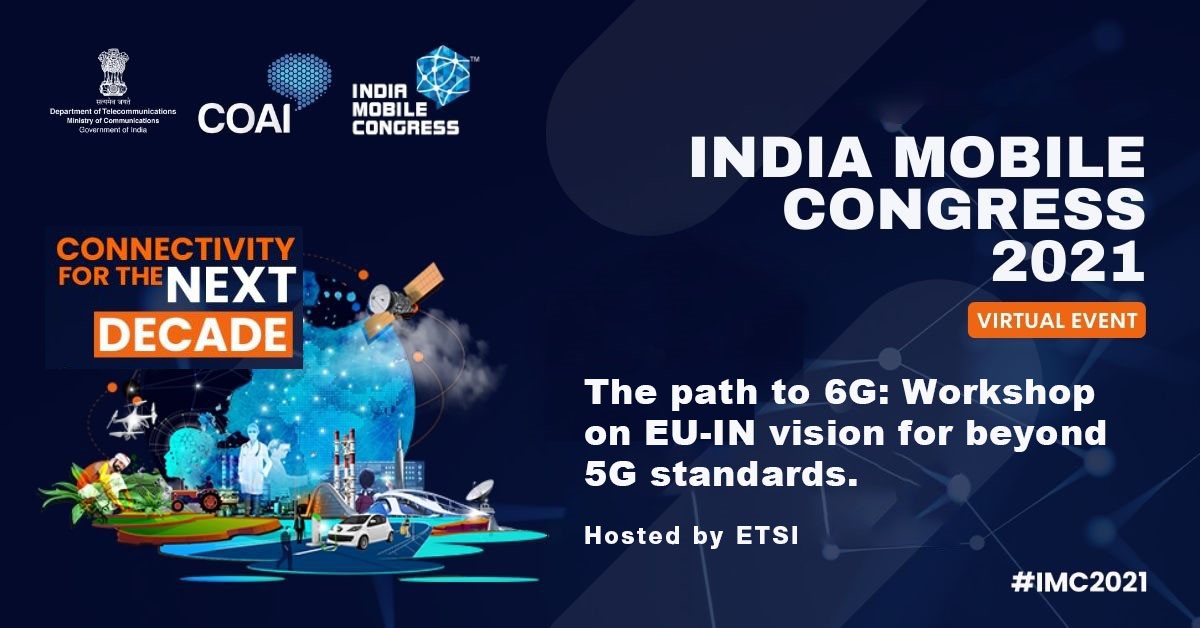
Held over 3 days from December 8 - 10, the India Mobile Congress is the biggest telecom industry event of the country, organized by the Cellular Operators Association of India (COAI). The fifth edition of the event brought together some of the biggest names in the Indian telecom space industry, including Telecom Minister Ashwini Vaishnaw . Reliance Chairman Mukesh Ambani, Airtel Chief Sunil Mittal and Vodafone Idea Co-Promoter Kumar Mangalam Birla.
The InDiCo project, implemented by ETSI, hosted one of the key workshop sessions on Day 1, entitled "The path to 6G: EU-India vision for beyond 5G standards", moderated by Xavier Piednoir, InDiCo project manager at ETSI.
R.K. Pathak, Deputy Director General in the India Department of Telecommunications and one of the key figures involved in the implementation of 5G, gave an opening statement highlighting the importance of connectivity to the whole world in achieving socio-economic goals. Adrian Scrase, ETSI's Chief Technology Officer, opened the session with a brief overview of the current state of 5G, with now 160 commercial networks around the world. He later added that 3GPP has ambitious plans to build on the foundations of 5G to improve efficiency and capability and expand the industrial deployment footprint. Looking forward it is important to note that new vertical industry sectors are becoming engaged in the development of the next generation of networks. And a large focus is going to be placed on sustainability, with a lot of work being invested in energy efficiency and energy saving. Artificial Intelligence and Machine Learning will become integral parts of future networks, which will enable significant network efficiency gains, moving towards complete automation of network management. It was also noted that global geopolitics will likely continue being a factor in the development and rollout of new standards and that the risk of standards fragmentation remains. The early success of 5G indicates that maintaining a single global standard is absolutely essential as it is a primary driver of interoperability and of the economic benefits that 5G brings.
Pertti Jauhiainen from the European Commission (DG CONNECT) outlined the 7 major traits that will likely define the next generation of 6G mobile networks - including Connected Intelligence (where the digital, physical and personal domains all converge), Programmability (where the network is more flexible and programmable), Deterministic (supporting deterministic end to end services), Sensing/Location (including high accuracy location and high resolution sensing capabilities), Sustainability (improved energy and resource efficiency), Trustworthiness (strong focus on security, performance, reliability and compliance) and Affordability/Scalability (ensuring the network is accessible to everyone, everywhere).
Emilio Davila-Gonzalez from the European Commission (DG CONNECT) provided an overview of the research activities that are happening in the 6G space and how public and private partnerships are being organized to speed this development. David Boswarthick, Director of New and Emerging Technologies at ETSI, highlighted that although 6G is still just at the vision and research phase, there are some exciting technological trends that will likely shape the future of beyond 5G, including things like holographic communications and immersive telepresence, tactile Internet of Senses, UAVs and autonomous vehicles, the metaverse where AI, VR and AR all blend, and the emergence of devices offering a brain/mind interface.
Professor Kiran Kuchi from IIT Hyderabad made it clear that India intends to scale up its presence in 3GPP and intends to have early prototypes of 6G-type of technologies ready by 2025. Early research is being conducted into Extreme Massive MIMO, Extreme Low Latency, 6G waveforms and Universal Connectivity leveraging both space and terrestrial dimensions. Prakash Ramasetty from TSDSI highlighted the importance of an integrated network of networks in 6G, enabling seamless and trustworthy interoperability between personal body networks all the way up to satellite networks.
The session allowed the exchange of a broad range of high-level viewpoints about the development of Beyond 5G networks.